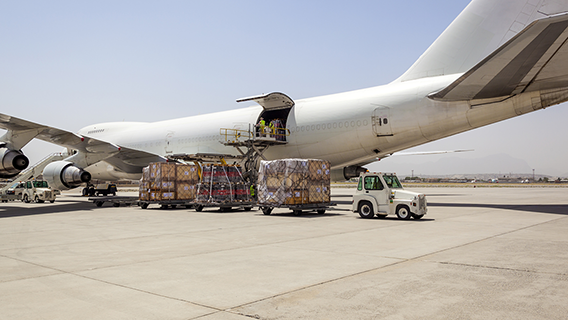
COVID-19 and Global Air Cargo
Contributed by Doug Brittin, Executive Director at Transportation Institute at the University of Denver
The Covid-19 impact on the airline industry goes well beyond the loss of passenger revenue. According to the International Air Transport Association (IATA), globally, air cargo represents over $6 Trillion of the value of world trade, accounting for nearly 35% of the total value. Passenger airlines carry a significant amount of that trade in the bellies of their aircraft, especially in international lanes where flight cutbacks are even more severe. Within Asia, where strong freighter networks do not exist, almost 45% of air cargo is carried on passenger planes. For transatlantic routes, the number is closer to 80%.
The worldwide transport of commodities such as medical supplies and equipment, vaccines, electronic and machine parts, perishables and other products will no doubt be affected. The recent (and ever growing) announcements by passenger carriers of reductions in both domestic and international flight operations will pose an increasing challenge in keeping supply chains functional and effective. However, these airlines are doing everything possible to continue to move as much air cargo as possible during the crisis. According to the IATA, Delta, Korean Air and others have advised that they will fly some routes using their passenger aircraft filling the lower decks with substantial amounts of cargo.
While freighter aircraft can make up some of the loss of cargo volumes, their flight frequencies and route structures around the world are more limited than those operated by passenger carriers. We are already seeing this impact with the longer transit times now being advised by domestic companies who fulfill online orders, and transit times globally have increased as well. In some international markets, rates have already more than doubled.
The freight forwarding industry has been rapidly adjusting to the shift in availability of aircraft and cargo space. In many instances both in and out of the US, they are quickly arranging for charter aircraft to meet demand.
The challenge is further compounded by the existing structure of commercial rights within bilateral and multilateral agreements between countries. These agreements impose restrictions on the ability for airlines to quickly change in air routes. In addition, some countries do not allow transit of certain goods through their territories. The closure of borders within Europe now limits the ability to readily move air cargo via surface transport that is still arriving or departing globally into key airport hubs.
The International Air Cargo Organization (ICAO) has recently issued State Letter Ref.: EC 6/3-20/46 dated 18 March 2020. In that document, ICAO is asking for “…facilitation of entry, departure and transit of aircraft engaged in relief flights and to implement all measures to facilitate the receipt of aid, including overflight and landing rights and necessary privileges and immunities for relief units…” among other measures. Shippers and consignees should continue to work closely with their freight forwarding partners to ensure they are aware of the most current information and options regarding bookings, operations, and schedules.
-
March 27, 2024
Denver Airport Spokesperson Credits her Communication Management Master’s
Ashley Forest's master's degree in Communication Management from University College propelled her career to new heights.
-
March 1, 2024
Q&A: Communication Management Program Looks Constantly Ahead
Academic Director Dr. Cindy Cragg keeps her finger on the pulse of the communications field in order to ensure the program stays cutting-edge and relevant to professionals in the industry.
-
February 2, 2024
For Great ROI, Invest in Yourself
If you’re seeking to expand your horizons, a University College credential can give you an exceptional education and help you stand out.
-
October 20, 2023
Celebrating Teaching Excellence: University College’s Esteemed Award Winners
Two members of the University College community were recognized this week for their embodiment of university excellence.